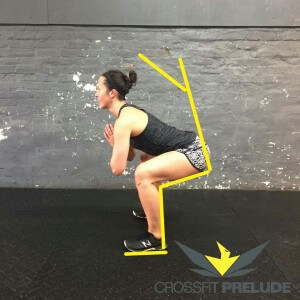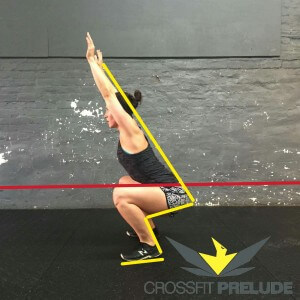“There is simply no other exercise, and certainly no machine, that produces the level of central nervous system activity, improved balance and coordination, skeletal loading and bone density enhancement, muscular stimulation and growth, connective tissue stress and strength, psychological demand and toughness, and overall systemic conditioning than the correctly performed full squat.” —Mark Rippetoe, Starting Strength
The squat is the most functional movement we do at the gym. Therefore, proper squat form is necessary to not only enable optimal strength gains, but also to prevent injury. Attention to detail and proper execution of the air squat, is just as important as proper execution of a loaded squat. As always, technique and mechanics trump load.
Every athlete squats differently, and while there is no one size fits all approach, there are certain fundamental tenants that should be adhered to:
1. Maintain Lumbar and Core Stability: Lumbar and core stability should be maintain throughout the entire movement, and specifically at the bottom of the squat. In other words, your lower back should not curve, and you should remain tight in the abdomen. Additionally, you should not lean excessively forward at any point. Leaning forward shift the weight from the midline, and will eventually result in back pain. If you squat with your hands in the “praying position” in front of you, you are more than likely causing your chest to fall, and as a result excessively leaning forward;

The “praying squat” causes the chest to fall forward, and also creates an inability to squat below parallel. Hands should be placed overhead, angled away from the body.
2. Keep Knees Inline with Toes: Knees should track over the toes. Additionally, make sure your knees aren’t caving in (valgus knees);
3. Drive Through Your Midfoot: Heels should remain on the ground, and force driving through your midfoot as you are coming up to full hip extension;
4. Maintain Your Balance: While driving through your midfoot, you should not have your weight shifted on your toes, or excessively on your heels. Your entire foot should remain in contact with the ground. Keeping your foot flat on the ground ensures you have uniform contact with the surface, and allows you to produce and transfer the maximum amount of force.
5. Stay in Control: Control should be maintained while you are lowering yourself (eccentric phase), and also when you are rising (concentric phase). You should feel controlled and tight, not loose and sloppy;
6. Look Forward: Your head remains neutral. In other words you are not looking up or down. It is a common misconception that you need to look up to keep your chest up, or look down to stop from falling back. Doing either of these throws your body out of wack, places your neck in a compromised position, especially if you are squatting with a barbell;
7. Go Below Parallel: Barring injury, you SHOULD ALWAYS SQUAT BELOW PARALLEL. In other words, Your hip crease should be below your kneecap. Consistently squatting above parallel creates a quad dominance, resulting in a muscle imbalance. A muscle imbalance will not only decrease your strength gains, but predisposes you to knee injury (ask runners and cyclist who fail to train their posterior chains). If you don’t have the mobility to squat below parallel, lower the weight until you are able to perform the correct range of motion. Additionally, it is imperative that you work on mobility outside of class (www.romwod.com is a good resource to improve your mobility).;

Failure to go below parallel will result in an imbalance and eventually injury. All squats should be performed below parallel.
8. Stand All the Way Up: Make sure you come to full hip extension with each movement (standing all the way up). Finishing with full hip extension is necessary in order to fully achieve glute activation; and
9. Stay Coachable: If a coach tells you you are not exhibiting a movement fault, don’t argue. Often, especially during the METCON, we sometimes lose body awareness. The purpose of performing movement correctly, is to prevent injury and create good movement patterns. The coach will direct you to reduce the weight; take a longer rest; or perform another movement in the hierarchy, for the safety and development of you as an athlete.

Linnea demonstrating the picture perfect air squat
To sum up, a properly executed squat is necessary to keep you healthy, and get you stronger. If you are exhibiting faults in your movement pattern, whether it be in the air squat, back squat, front squat, or any derivative movement, the coaches will provide you with the instruction to get you better. Be open to instruction, as it is the only way you will perform better, and stay injury free.
Have fun, and keep crushing your goals.
“There is simply no other exercise, and certainly no machine, that produces the level of central nervous system activity, improved balance and coordination, skeletal loading and bone density enhancement, muscular stimulation and growth, connective tissue stress and strength, psychological demand and toughness, and overall systemic conditioning than the correctly performed full squat.” —Mark Rippetoe, Starting Strength
The squat is the most functional movement we do at the gym. Therefore, proper squat form is necessary to not only enable optimal strength gains, but also to prevent injury. Attention to detail and proper execution of the air squat, is just as important as proper execution of a loaded squat. As always, technique and mechanics trump load.
Every athlete squats differently, and while there is no one size fits all approach, there are certain fundamental tenants that should be adhered to:
1. Maintain Lumbar and Core Stability: Lumbar and core stability should be maintain throughout the entire movement, and specifically at the bottom of the squat. In other words, your lower back should not curve, and you should remain tight in the abdomen. Additionally, you should not lean excessively forward at any point. Leaning forward shift the weight from the midline, and will eventually result in back pain. If you squat with your hands in the “praying position” in front of you, you are more than likely causing your chest to fall, and as a result excessively leaning forward;

The “praying squat” causes the chest to fall forward, and also creates an inability to squat below parallel. Hands should be placed overhead, angled away from the body.
2. Keep Knees Inline with Toes: Knees should track over the toes. Additionally, make sure your knees aren’t caving in (valgus knees);
3. Drive Through Your Midfoot: Heels should remain on the ground, and force driving through your midfoot as you are coming up to full hip extension;
4. Maintain Your Balance: While driving through your midfoot, you should not have your weight shifted on your toes, or excessively on your heels. Your entire foot should remain in contact with the ground. Keeping your foot flat on the ground ensures you have uniform contact with the surface, and allows you to produce and transfer the maximum amount of force.
5. Stay in Control: Control should be maintained while you are lowering yourself (eccentric phase), and also when you are rising (concentric phase). You should feel controlled and tight, not loose and sloppy;
6. Look Forward: Your head remains neutral. In other words you are not looking up or down. It is a common misconception that you need to look up to keep your chest up, or look down to stop from falling back. Doing either of these throws your body out of wack, places your neck in a compromised position, especially if you are squatting with a barbell;
7. Go Below Parallel: Barring injury, you SHOULD ALWAYS SQUAT BELOW PARALLEL. In other words, Your hip crease should be below your kneecap. Consistently squatting above parallel creates a quad dominance, resulting in a muscle imbalance. A muscle imbalance will not only decrease your strength gains, but predisposes you to knee injury (ask runners and cyclist who fail to train their posterior chains). If you don’t have the mobility to squat below parallel, lower the weight until you are able to perform the correct range of motion. Additionally, it is imperative that you work on mobility outside of class (www.romwod.com is a good resource to improve your mobility).;

Failure to go below parallel will result in an imbalance and eventually injury. All squats should be performed below parallel.
8. Stand All the Way Up: Make sure you come to full hip extension with each movement (standing all the way up). Finishing with full hip extension is necessary in order to fully achieve glute activation; and
9. Stay Coachable: If a coach tells you you are not exhibiting a movement fault, don’t argue. Often, especially during the METCON, we sometimes lose body awareness. The purpose of performing movement correctly, is to prevent injury and create good movement patterns. The coach will direct you to reduce the weight; take a longer rest; or perform another movement in the hierarchy, for the safety and development of you as an athlete.

Linnea demonstrating the picture perfect air squat
To sum up, a properly executed squat is necessary to keep you healthy, and get you stronger. If you are exhibiting faults in your movement pattern, whether it be in the air squat, back squat, front squat, or any derivative movement, the coaches will provide you with the instruction to get you better. Be open to instruction, as it is the only way you will perform better, and stay injury free.
Have fun, and keep crushing your goals.
